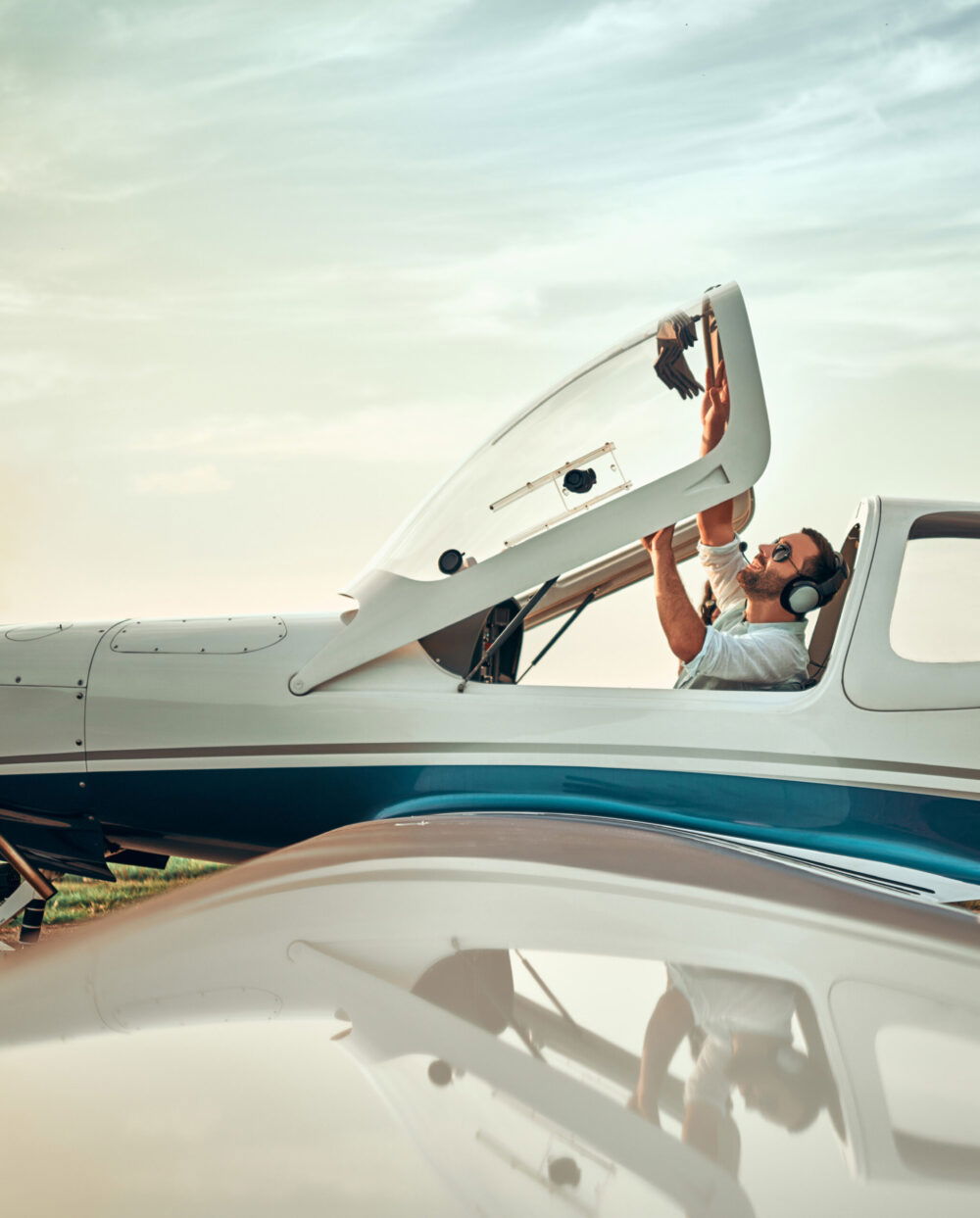The Tecnam P2012 Traveller is one of those unusual airplanes that when you first see it makes you ask, why did they do that? An 11-seat, fixed-gear unpressurized utility twin powered by a pair of Lycoming piston engines? Who would buy the thing? A rapidly growing U.S. commuter airline that needs exactly this airplane, that’s who.
The development of the P2012 began in 2012 at the request of launch customer Cape Air, the Massachusetts-based island-hopping scheduled air service that flies an aging fleet of Cessna 402s, the care and feeding of which is becoming all but impossible to sustain profitably. In recent years Cape Air has expanded from its bread-and-butter turf in New England south to Florida and the Caribbean, into the Midwest and more recently to the Mid-Atlantic region. As the airline grows, fleet replacement has become a pressing concern.
function jssiInit2($) { var jssiWidget2 = JSSIUniversal.tag($(“#cdddashboarduniversal”), { userId: “”, referId: “16” }); }The Cessna 402, of course, is long out of production, and no manufacturer offers an airplane that truly fits Cape Air’s unique mission requirements. The company’s executives initially approached Cessna and Piper about producing a clean-sheet airplane but didn’t get far with those discussions. So they turned to Tecnam, the Italian light airplane maker that builds the four-seat, Rotax-powered P2006 twin. Could Tecnam build a larger version of that airplane, Cape Air wondered, one that perhaps would have eight seats and four Rotax engines?
The answer was a resounding no. But Tecnam was happy to discuss an even grander alternative: a totally new piston twin that would be designed from the very first rivet with Cape Air’s operating and maintenance requirements squarely in mind.
Begin to peel back the layers of complexity beneath the P2012’s aluminum skin and the thoughtfulness and subtle ingenuity behind the design soon emerge. Though it has a high wing, the P2012’s baggage compartment sits low to the ground to make loading on the ramp easier. To allow for quick-turn maintenance, all the passenger seats and the entire cabin floor can be removed by a single person in minutes. That allows the P2012 to undergo necessary periodic inspections and other routine maintenance during a single overnight shift. The fixed gear cuts down on complexity, and because there’s no impact from the main gear on the wing spar, as there is on the Cessna 402, the P2012 should be able to remain in service with Cape Air for decades.
| Base Price | $2.53 million | Max Gross Weight | 8,069 lb. |
| Price as Equipped | $2.6 million | Payload | 2,491 lb. |
| Engines | Lycoming TEO-540-C1A, 375 hp | Useful Load | 3,073 lb. |
| Propellers | MT-Propeller, 4-Blade | Max Usable Fuel | 198 gal. |
| Seats | 11 | Service Ceiling | 23,000 ft. |
| Length | 38.6 FT. | Max Rate of Climb | 1,250 fpm |
| Height | 14.4 FT. | High Speed Cruise | 194 kTas |
| Wingspan | 46 ft. | Normal Cruise | 173 kTas |
| Wing Area | 273.7 sq. ft. | Max Range | 950 nm |
| Wing Loading | 29.6 lb./sQ. ft. | Stall Speed, Flaps Up | 72 kias |
| Power Loading | 10.8 lb./hp | Stall Speed, Full Flaps | 69 kIas |
| Ramp Weight | 8,113 lb. | Take Off Over 50 feet | 2,159 ft. |
| Empty Weight | 5,040 lb. | Landing Over 50 feet | 1,801 ft. |
A Study in Contradictions
You might reason that an established airline’s decision to turn to a relatively small Italian aircraft manufacturer best known for its lineup of piston light sport aircraft could be something of a roll of the dice. That assumption, however, ignores the long history of this manufacturer going back many decades, to when the Pascale brothers from Naples first began producing airplanes as young men in their 20s.
I traveled to Capua, Italy, recently to fly the P2012 and learn more about a company that, like many pilots in America, I’ve only watched from afar. Tecnam, I quickly learned, is a study in contradictions—a manufacturer that simultaneously can be considered old and new, small yet large, innovative but still resolutely connected to its storied past.
Take the Tecnam factory in Capua, for instance. A short drive north from Naples, it is nestled among ancient olive groves in a part of Italy that is famous for its mouthwatering buffalo mozzarella—and, within Europe at least, airplane production. The original company founded by brothers Luigi and Giovanni Pascale traces its origins to 1948. Partenavia was the name of the manufacturer then, and some of the earlier airplanes the company built remain in production to this day, the type certificates now owned by another Italian company, Vulcanair.
For an airplane manufacturer with such a rich history, you might expect the factory to be a holdover from a bygone era, with aging tooling inside rundown facilities. Nothing could be further from reality. The brand-new factory is a gleaming testament to an aviation family that has faced down adversity and dusted itself off after a fall from prosperity to reemerge once again as a force in light-aircraft production.
The Pascale bothers’ original aim with Tecnam was to produce aircraft components for ATR and Boeing, but they soon had the itch to get back into serial aircraft production.
If you’re not familiar with the story, it all went wrong for Partenavia and the brothers after the Italian government began consolidating the country’s aerospace industry in the 1950s and 60s. A number independent companies were forced to merge with the aviation division of Fiat, leading to the creation of Aeritalia in 1969. In 1981, Partenavia was swallowed up by the behemoth Italian conglomerate, which was already showing the signs of stress caused by years of mismanagement and government interference. The brothers remained with Aeritalia for a time, but the firm eventually went bankrupt and all their hard work over the decades vanished seemingly overnight.
Out of a job and with the type certificates to some of their best-regarded airplanes now in the hands of others, the brothers decided to start over from scratch by forming Costruzioni Aeronautiche Tecnam, the firm’s formal full name. The first Tecnam product was the P92 Eaglet, an LSA based on an earlier Partenavia design from the 1960s. The “92” in the name denotes the year the of the airplane’s design, 1992, a convention that has carried over to other Tecnam products—hence the P2012 was designed in 2012 even though it earned its EASA certification in 2019.
In the intervening years there have been a handful of other LSA models—the P96, P2002, P2004, P2008 and Astore—the Rotax-powered P2006 twin and a Part 23-certified single, the P2010.
The aeronautical genius behind each and every model the company has produced throughout its history, Luigi Pascale—known affectionately as the “Professor” for the time he spent teaching aerodynamics at the University of Naples—died in March 2017, but his legacy lives on at the family-owned company that is today headed by Paulo Pascale, Luigi’s nephew and Giovanni’s son. The P2012, the last airplane Luigi designed, elevates the Tecnam brand even further, and could propel the firm, with 350 employees in Capua, to lofty new heights that it never realized even in its heyday in the 1960s.
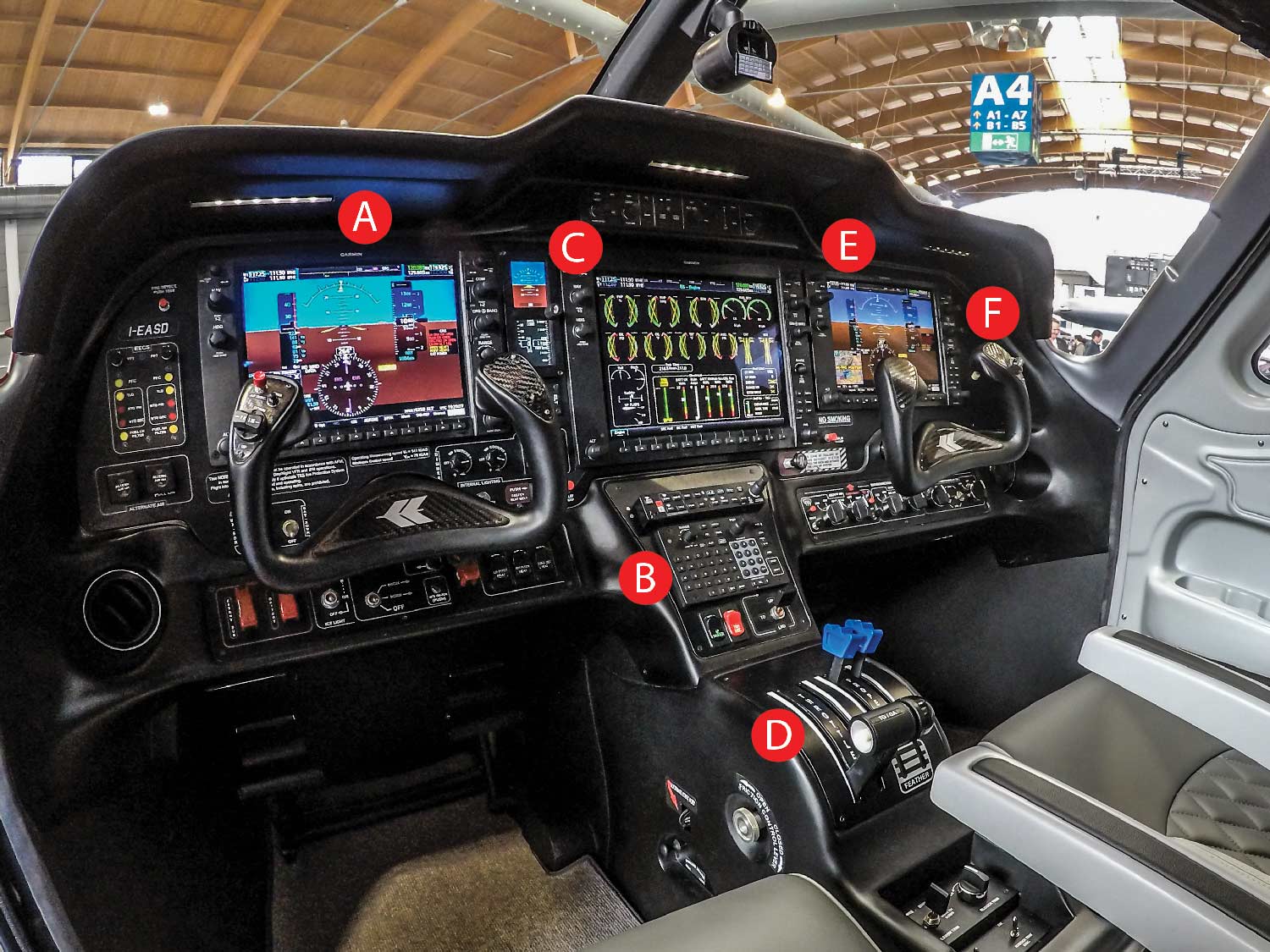
A. Garmin’s G1000 NXi avionics system will be familiar to any pilot who has flown behind the cockpit, which has been upgraded in its latest iteration with faster processors and improved displays.
B. A dedicated keyboard makes entry of flight-plan data a breeze, a feature that should win accolades from Cape Air pilots who will fly the P2012 alone.
C. Backup instrumentation is provided by the compact Mid-Continent MD-305 LCD display, which includes its own emergency battery with 60 minutes of charge.
D. Thanks to the electronic computer brains of the Lycoming TEO-540 engines, starting is easy and there is no need for mixture controls.
E. The digital Garmin GFC 700 autopilot has been tailored to the flight characteristics of the P2012. It is smooth and precise, which should translate to a comfortable ride for Cape Air passengers.
F. Flight-related information is supplied by two primary flight displays, while moving map, engine pages and other data are available on a large center multifunction display.
Flying the P2012
The contrast between old and new at Tecnam became apparent as soon as I strapped into the P2012’s cockpit with chief test pilot Lorenzo De Stefano, a former Italian air force pilot, and we began taxiing toward the runway. “Should we really be doing this?” was the question that came to mind as we rolled off the paved taxiway that leads from the factory to the “runway”—in reality a muddy grass strip measuring just 1,800 feet long. De Stefano in the left seat pushed the power levers forward and we lumbered sideways through muddy ruts, jouncing over deep gashes in the nutrient-rich Italian soil that were filled with at least a foot of water. The strip had only recently reopened after torrential rains forced its closure for an entire week before my arrival in Italy. Just as I was starting to question our sanity for considering taking off from such a short runway in a large airplane in these conditions, the field toward the departure end began to dry out considerably. A cursory glance at the runway surface confirmed that it was in much better shape than the slightly lower elevation off to the side where we were taxiing. I watched as the Tecnam P2010 single ahead of us—the photo ship for the air-to-air photography session that would be a part of this sortie—accelerated on the runway and lifted into the sky with ease. OK, let’s do this.
Having completed the run-up and other preflight checks on the ramp, De Stefano confirmed I was set to go, then swung the P2012 onto the runway, advancing the power to the forward stops. We rocketed on the uneven surface, bouncing along until the ground fell away far sooner than I expected, with a ground roll of perhaps 900 feet at our relatively light weight.
As we joined up with the P2010 over the Italian coast and flew past Ischia, a densely populated volcanic island that lies at the northern end of the Gulf of Naples, a captivating backdrop for our photos, another of the peculiarities of Tecnam was in full display: At the controls of the P2010 photo ship was none other than Paulo Pascale, a rarity indeed these days when the heads of many aircraft manufacturers are more likely to be bean-counting MBAs rather than experienced pilots.
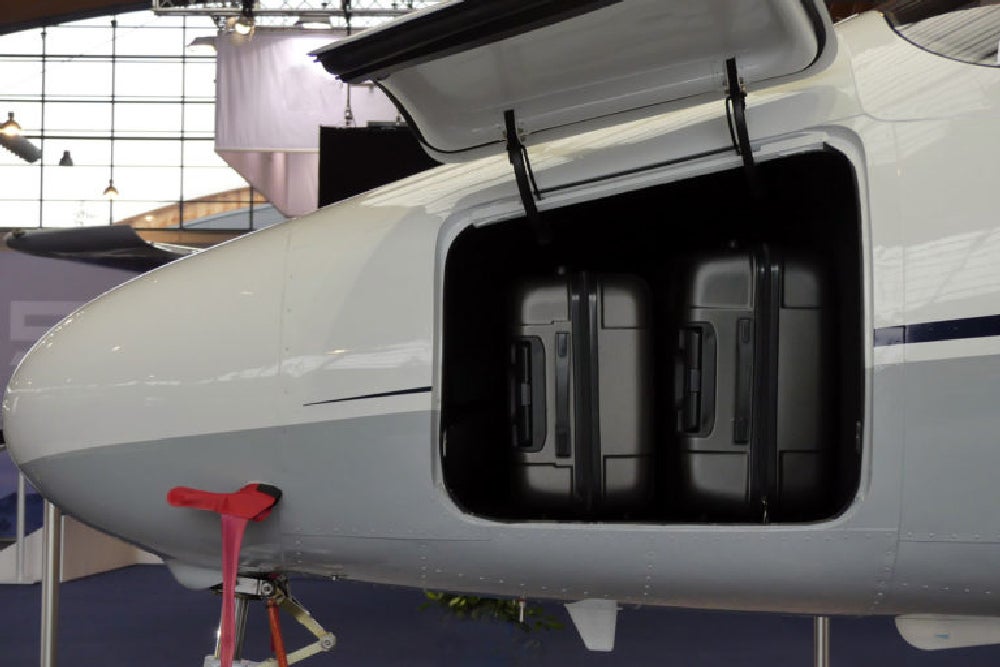
When it was my turn to take the controls, I found the P2012 to be quite heavy in roll and pitch, though I was pleased that the two forces were equally balanced. The airplane is a bit of a chore to hand fly, but that doesn’t mean it’s difficult to fly—another of those Tecnam contradictions I was coming to appreciate. As I threw the airplane around along the coast in a block of airspace we had negotiated with ATC, I found the P2012 to be quite fun to fly. It will be a solid platform for Cape Air’s pilots, many of whom eventually will move on to the airlines and should feel right at home manipulating heavy controls at their new jobs.
The P2012’s electronically controlled Lycoming TEO-540-C1A engines produce 375 hp per side. Featuring single-lever control—there are no mixture controls—the six-cylinder horizontally opposed turbocharged engines are a good choice for ham-fisted pilots. The TEO-540’s electronic fuel injection and electronic ignition represent the current state of the art in piston aero-engine design.
The engine has an automotive-type starter, one 28V alternator and a propeller governor pad. The electronic engine-control system is a microprocessor-controlled setup which continuously monitors and adjusts ignition timing, fuel injection timing and fuel mixture based on operating conditions. The EECS eliminates the need for magnetos and any kind of manual fuel/air mixture control.
The main advantages and features of the Lycoming engines include reduced fuel consumption and the active engine protection it affords against knock, overboost and high temperatures, thereby ensuring a more trouble-free existence compared with older-generation turbocharged engines.
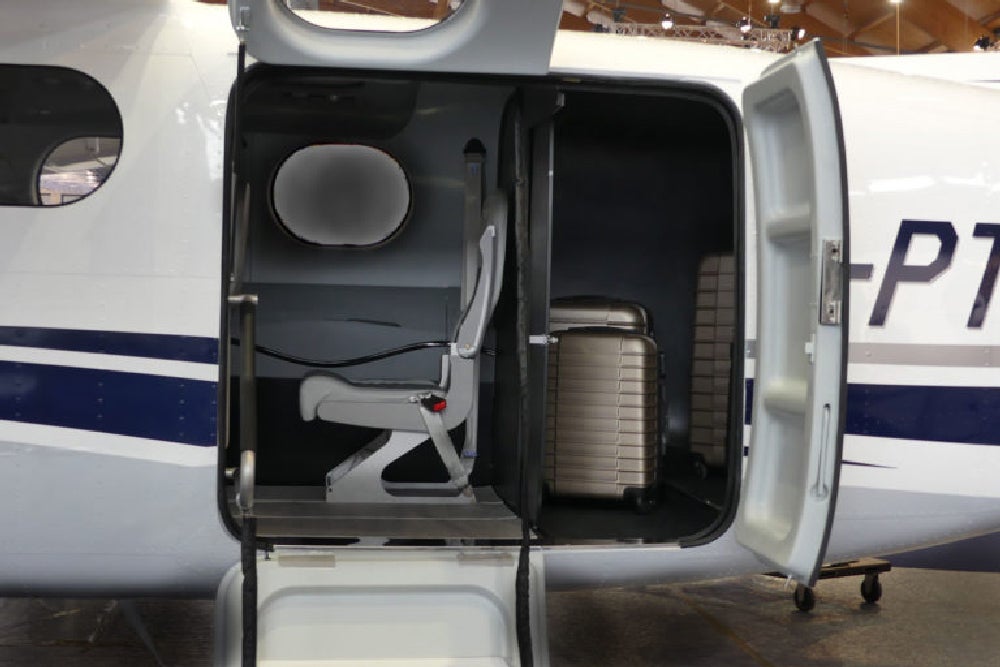
The cockpit of the P2012 will be familiar to any pilot who has flown with Garmin’s G1000 system. The latest NXi iteration includes faster processors and brighter displays, as well as additional features such as visual approach capability and a moving-map overlay on the HSI that pilots are learning to appreciate.
The P2012 cockpit also includes a full keypad to ease flight-plan entry. Options in the P2012 include TKS icing protection, Garmin weather radar and air conditioning.
For the landing back at the Tecnam factory, De Stefano asked if I’d like a demonstration of the P2012’s steep approach capability.
I said I would, and from a considerable height above the runway he chopped the power and pointed the nose at a steep angle toward the green earth below. The term “lawn dart” came to mind. With full flaps set, the airspeed didn’t climb much even with our rapid rate of descent. De Stefano picked out an aiming point well before the runway threshold before rounding out and settling into ground effect, planting us on the runway and coming to a stop in ridiculously little space. The broad smiles on both our faces as we pulled off the runway were a testament to an airplane that Cape Air pilots, I believe, will come to love in time.
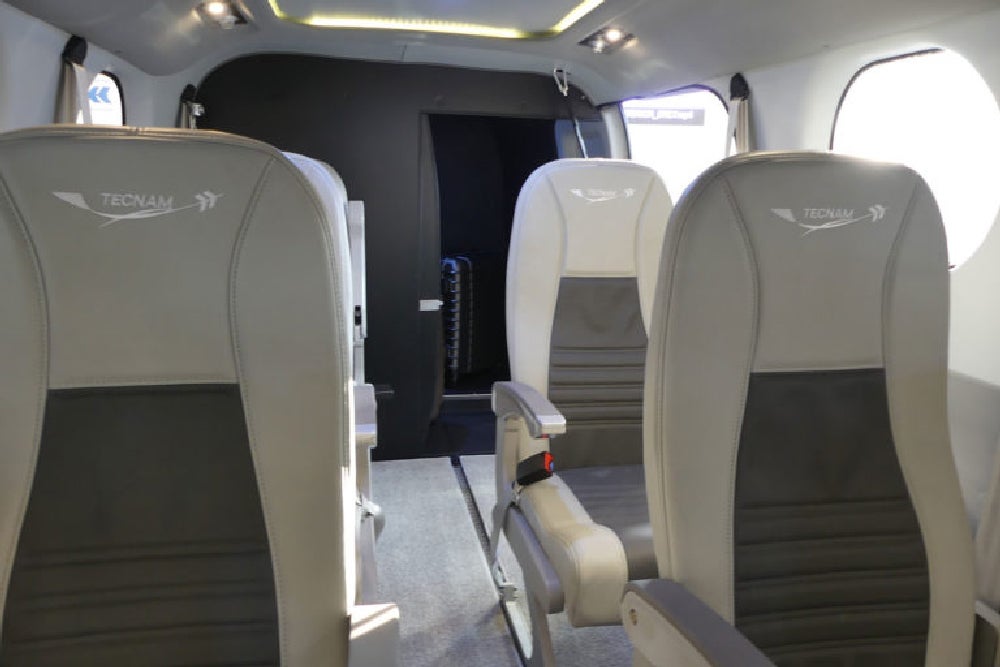
The P2012 could also be a compelling alternative in the owner-flown market to turboprops such as the Cessna Caravan and Quest Kodiak. It’s more economical, can carry a heavy load and is nearly as fast. Given its pedigree as a rugged commuter airliner, it’s an airplane a pilot could buy and keep for many years of enjoyment for far-flung aerial adventures.
The standard commuter cabin includes nine spartan seats that are surprisingly comfortable and positioned for excellent visibility through the airplane’s large windows. A hard wall at the rear of the passenger compartment blocks the view of baggage in the rear, and there’s also space in a nose compartment for more bags. Combination commuter-cargo versions of the P2012 will be offered, as well as an amphibious option that Tecnam thinks will be immediately popular with operators in the Caribbean. The VIP version of the P2012 will be offered with a luxury executive interior, and can also be optioned with extra cargo space, the firm said.
Tecnam got FAA certification of the P2012 in August of 2019 after the original certification timeline slipped slightly because of the U.S. government shutdown the previous winter.
Cape Air now has the first 30 airplanes it has on order as production in Italy starts to ramp up. Ten more are expected in 2022 as the company ramps up toward 100.
For the pilots who will get to fly the P2012 on a regular basis, that goal can’t come soon enough.




